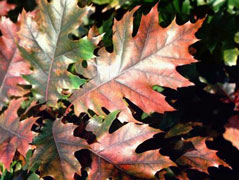


Home
Flowers &
Indoor Plants
Fruits & Nuts
Ornamentals
Vegetables
Special Topics
Resources
Glossary

|
Red Oak Quercus rubra (kwhere-kuss roo-bra)   Click on thumbnails for larger image. |
 |
What about it? The red oak is a deciduous tree that grows to a height of 75 feet. Unlike the maples, it has alternating leaves and branches. There are several different species of oaks including; red, black, and white. White oaks have the rounded leaves and red and black have the shorpley pointed lobes. Black oak leaf lobes cut in much deeper than the red oak lobes. All oaks produce acorns. Some folks say the white oak acorns are edible if you boil them for hours and hours to remove a substance called tannins. For the most part, though, acorns are a favorite food of squirrels. What is it used for? Red oaks are one of the fastest growing oaks and provide a good deal of shade. This makes them popular as lawn or street trees. Red oaks are very tolerant of urban conditions which makes them a popular city park tree. Red oak leaves turn mellow shades of rusty-red, gold, or sandy-brown in the fall. Where does it grow? How do we grow it? Red oaks are tolerant of rather dry soil conditions. other large tree. They should be planted 50 feet away from any other large tree.What are its primary problems? The red oaks can be troubled by scales, leaf blister, and Anthracnose. Oak wilt can be a major problem but it has not been found anywhere north of Pennsylvania. Red oaks are also targets for galls. Galls are insect "homes" in the oak leaves. A mother insect will inject her eggs into a leaf along with a hormone that causes the leaf to puff into a big ball. This way the baby insect is protected from predators and when it hatches it doesn't have to search for its food.
© Copyright, Department of Horticulture, Cornell University. |